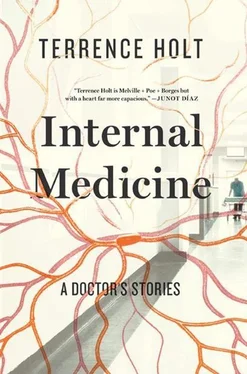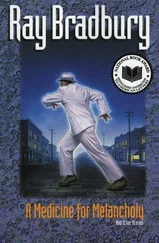Most nights there would be only three or four admissions to review, and in most cases my contribution was nothing more than a quick summation of the intern’s findings and a listing of the key points of the medical plan. Whenever the intern’s note suggested anything worrisome, however, it was part of my responsibility to repeat the history and physical.
In that environment, knowing what to worry about and what to ignore was sometimes hard. As historians, the patients were not unreliable so much as inscrutable. When a woman tells you she has a baby in her finger that’s one thing; but when she tells you she feels crushing pressure in her chest every time she climbs the stairs without a towel around her head, that’s another. These were patients capable of hiding, behind the fog and mirrors of madness, all manner of disease.
For all my worries, whatever I felt called on to investigate turned out usually to be straightforward: the patient had come in with a fever, or the admission labs had revealed some metabolic derangement, or there had been a complaint elicited on history like fainting spells or a recent assault. If the intern had been busy, or the patient less than cooperative, these things might have escaped a workup. Occasionally something subtler would catch my eye: some inconsistency in the history, usually, that would start me worrying. And sometimes it was just a hunch. I’m not a fan of hunches, generally: too often they’re shorthand for a diagnostic process being rushed. But in a psychiatric hospital it seemed inevitable that decision-making should hinge on the shadowy unnamed.
It was one of those shades of doubt that led me to pull Carrie B back off the stack of papers I had reviewed. She had been the third of five admitted overnight, and the one after her, with HIV and hepatitis C, a fever and abdominal pain, had consumed an hour of my time, during which the intern had been paging me repeatedly from the floor, where his handling of a series of emergencies ranging from constipation on Gero to a scalp laceration on Acute Men’s required my oversight and approval. And I had ordered a pizza, which was by now getting cold at the reception desk. But something about Carrie B bothered me, and I pulled her sheaf of papers off the stack for another reading.
As charts went, hers was nothing special. In her previous admissions, she had been too healthy to warrant much in the way of medical attention; the bulk of her chart was devoted to psychiatric treatment, in which I generally took little interest beyond noting the primary diagnosis. Her prior admissions had been for self-injury and borderline personality disorder. Now she was back again for the same thing: a few slices at the volar surface of her left wrist, too superficial (in the intern’s assessment) to warrant suturing, which is usually the case in the ones that survive.
None of this accounted for the anxiety her account set roaming in my chest. What had gotten my attention was something else: the description in the “General” section of the physical exam. This usually consists of the rote WDWNWF, A&Ox3, NAD (for “a well-developed, well-nourished white female, alert and oriented to person, place, and time, in no apparent distress”). For Carrie B the intern had taken the time to interpolate a relatively prolix uncomfortable-appearing . She had also exhibited pain with deep inspiration, as well as with palpation of the liver. I considered the relatively brief list of what could cause such things. There had been no prolonged travel or immobilization suggestive of clots migrating from legs to lungs, no recent trauma or motor vehicle collisions, no report of an alcoholic binge; vital signs were unremarkable; urine pregnancy test was negative. Her admission blood work was still in the lab.
Without having actually laid eyes on her, I knew uncomfortable, pleuritic, tender-livered Carrie B might be harboring any of a dozen different processes that could carry her off by sunrise Sunday: but it seemed unlikely. More probably she was (as the expression has it) “responding to internal stimuli.” This is a phrase psychiatrists love. “Responding to internal stimuli” means the patient is hallucinating. It’s a way of characterizing crazy behavior that sounds more clinical than it is. Only a crazy person responds to internal stimuli. But she had no history of psychosis. She was simply a borderline.
Borderline personality disorder, I had learned in medical school, like all personality disorders, occupies a gray area between the transient disturbances common to us all and the major diseases of mood or cognition. This gray terrain is not the borderline the term refers to, however. People carrying this diagnosis predictably lead lives of chaotic instability, alternately attaching to and breaking from, with equal violence, the people around them. Everyone with whom they have to do for more than a few hours they either idealize or demonize. Craving attention, they are said to suffer from a deficient sense of self. Asked how they feel when they’re alone, generally they’ll say, “Empty.” The border they inhabit is the one between having a personality and not.
None of this qualifies as psychotic. Sometimes borderlines will produce symptoms simply for the attention, but outright shamming is usually reserved for highly specific, tactical maneuvers: chest pain on the day of discharge, for instance. The need for attention runs deep; they prefer actual physical disease to simulation: hence the self-injury. Whatever was bothering Carrie B seemed to me more likely physical than delusional. But the presentation was so vague, it could be anything. Had she been assaulted? Was she harboring a broken rib? A collapsed lung? Had she swallowed something? Was her gallbladder going bad?
I leaned to the gallbladder. It was an explanation I liked for several reasons: it was probable, it was not alarming (medically or spiritually), and the workup was relatively straightforward. But there were all those other things that needed ruling out. With a brief pang about the pizza cooling on the reception desk, I shoved the chart back in the rack and asked the charge nurse if she could bring Ms. B to the examining room.
The examining room was a closet off the common room. Its door, like every other door in the facility, was kept locked, separating the patients from the needles and knives, alcohol and iodine they would be better off without. Having the master key, I could have let myself in and waited while the nurse fetched Carrie B, but I am just claustrophobic enough that I preferred to wait outside.
Which meant I had to wait in the common room, where the same women who had mobbed me on entering the ward now milled around, waiting for the distribution of evening meds, watching television, or simply milling. In this environment, standing motionless conferred a small measure of protection against direct importunities. To be still and quiet in that setting was to make oneself practically invisible.
I stood against the wall and watched. A dozen women, dressed in pajamas, sweat suits, or oversized hospital gowns worn as a drab sort of muumuu, were gathered restlessly before the locked Dutch door of the medication room. The rest were watching, more or less, the television, which from its bracket high on the opposite wall emitted a nearly continuous series of deep-chested thuds. A car rolled over and burst into flames, bringing a loud cheer from a group on the sofa, when the nurse rounded the corner with Carrie B in tow.
Even across the common room she was visibly uncomfortable. She walked as though made of something thin and brittle. When the group on the sofa hooted, she flinched, but even in flinching she held her upper body rigid.
In the examining room, with the nurse’s assistance she climbed carefully onto the table, bracing herself on her arms as she sat on one end. Looking up from the chart, I identified myself. She looked at me, her features thin and pinched, her gaze a little too direct. There was a pause, during which she sniffed once or twice, and shifted uncomfortably on her perch.
Читать дальше












